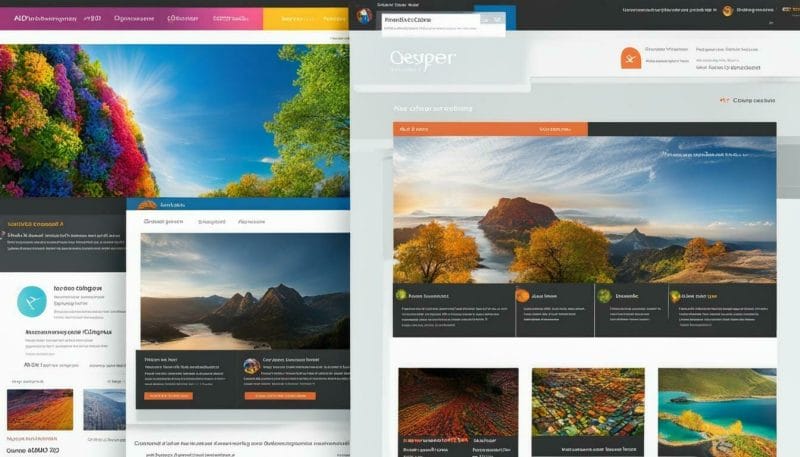Are you wondering how many ad groups you should have in your Google Ads campaign? Look no further – Loudachris Digital Marketing has the answers and expertise to help you make the most out of your ad campaigns.
When it comes to running successful Google Ads campaigns, having the right number of ad groups is crucial. The number of ad groups you should include in a campaign depends on various factors such as your advertising goals, target audience, and the complexity of your offerings. It’s essential to strike the right balance between having enough ad groups to effectively target your audience and not overwhelming yourself with too many groups to manage.
At Loudachris Digital Marketing, we understand the intricacies of Google Ads and can guide you in creating an optimal ad group structure for your campaigns. Our expertise and industry knowledge allow us to maximise your campaign’s performance and drive better results.
- Ad group structure and organization play a significant role in the success of your Google Ads campaigns.
- Loudachris Digital Marketing can help you determine the right number of ad groups for your specific campaign goals.
- Creating ad groups that align with your target audience and keywords can improve the effectiveness of your ads.
- Optimizing ad strength can lead to higher conversions, and our expertise can assist you in achieving this.
- Utilizing performance-driven strategies and monitoring other factors like quality score can enhance your campaign’s overall performance.
With Loudachris Digital Marketing by your side, you can confidently navigate the complexities of Google Ads and ensure your campaigns are optimised for success. Contact us today to take your ad campaigns to the next level!
Ad Group Limit and Campaign Organization
Google Ads imposes a limit on the number of ad groups you can have within a single campaign, but understanding how to organize your campaigns is equally essential for optimal performance. By structuring your campaigns effectively, you can maximise the impact of your ads and improve your overall campaign success.
When organizing your Google Ads campaigns, it is best to create multiple campaigns, each focused on a specific goal. This allows you to tailor your ads and ad groups to the specific needs of your target audience. By dividing your campaigns based on different products, services, or target demographics, you can ensure that your messaging is relevant and resonates with your intended audience.
Within each campaign, it is important to create ad groups around a narrow theme. This ensures that your keywords are highly relevant to the ads within each group and helps improve your Quality Score. For example, if you are a digital marketing agency, you may create different ad groups for services such as SEO, social media marketing, and PPC advertising. This allows you to create ads that directly address the needs and interests of users searching for those specific services.
| Best practices for organizing your ad groups: |
|---|
| 1. Group keywords by theme or topic. |
| 2. Create ad groups with a clear focus on a specific product or service. |
| 3. Use relevant ad copy that aligns with the keywords in each ad group. |
| 4. Optimise your ad rotation to ensure you are showing the most effective ads. |
By structuring your campaigns with clear goals and organizing your ad groups effectively, you can maximise the performance of your Google Ads campaigns. This can result in increased click-through rates, improved Quality Scores, and ultimately, more conversions.

Remember, while Google Ads does impose a limit on the number of ad groups per campaign, it is equally important to focus on campaign organization for optimal performance. Loudachris Digital Marketing can help you in creating and managing your campaigns, ensuring that your ads are structured effectively and aligned with your business goals. Contact us today to optimise your Google Ads campaigns and drive better results.
Ad Group Structure and Best Practices
Creating a well-structured ad group is crucial for achieving success in your Google Ads campaigns. Let’s explore the best practices for crafting ad groups that yield results.
Ad Group Structure
When organizing Google Ads campaigns, it is best to create multiple campaigns, each focused on a specific goal. Within each campaign, ad groups should be created around a narrow theme with keywords related to that theme. This allows for better targeting and relevance, leading to higher click-through rates and conversions.
It is recommended to have a maximum of 20 keywords per ad group to maintain relevance and make it easier to manage and optimise your campaigns. Additionally, each ad group should have at least three ads, utilising optimised ad rotation to test different variations and determine the most effective messaging for your target audience.
Optimizing ad copy is crucial for driving engagement and conversions. Your ad copy should be concise, relevant, and engaging, with a clear call-to-action. Incorporate your keywords strategically to improve ad relevance and quality score. Remember to regularly review and update your ad copy to ensure it remains fresh and compelling.
Best Practices
Here are some best practices for creating and managing your ad groups:
- Group keywords based on relevance and similarity to improve ad relevance and quality score.
- Create ad groups with a specific target audience in mind, allowing you to tailor your messaging and offers to their needs and preferences.
- Regularly monitor and optimise your ad groups by analyzing performance metrics such as click-through rates, conversion rates, and cost per conversion.
- Utilize ad extensions to provide additional information and increase the visibility of your ads.
- Test different ad formats, such as text ads, responsive ads, and image ads, to identify which ones resonate best with your audience.
By structuring campaigns with clear goals, organizing ad groups effectively, and implementing these best practices, you can maximise the performance of your Google Ads campaigns and achieve your advertising objectives.

In summary, creating well-structured ad groups is essential for successful Google Ads campaigns. Remember to organize your campaigns and ad groups based on specific goals and themes, incorporate relevant keywords strategically, and regularly monitor and optimise your ads. By following these best practices, you can increase ad relevance, improve click-through rates, and drive conversions.
| Table Heading 1 | Table Heading 2 |
|---|---|
| Table Data 1 | Table Data 2 |
| Table Data 3 | Table Data 4 |
Ad Group Segmentation and Strategy
Ad group segmentation allows you to target specific audiences and keywords, making your ad campaigns more focused and strategic. Let’s explore how this can benefit your advertising efforts.
When it comes to Google Ads, segmenting your ad groups is crucial for achieving optimal performance. By grouping keywords and ads that are closely related, you can create targeted campaigns that resonate with your audience. This not only improves the relevance and quality of your ads, but also helps you allocate your budget more effectively.
One of the key benefits of ad group segmentation is the ability to tailor your messaging to different customer segments. By creating ad groups for specific demographics, locations, or interests, you can deliver highly personalised ads that speak directly to your target audience. This level of customisation can significantly improve your click-through rates and overall campaign performance.
Effective ad group segmentation also allows you to:
- Optimize your bidding strategy by grouping keywords with similar performance metrics together
- Test and refine different ad variations to find the most effective messaging
- Monitor and analyze the performance of each ad group separately, allowing you to make data-driven optimisations
By implementing a strategic ad group segmentation strategy, you can ensure that your ads are shown to the right people at the right time, maximising your chances of success. With Loudachris Digital Marketing’s expertise in ad group optimisation, we can help you create a well-structured and highly targeted campaign that drives results.

| Benefits of Ad Group Segmentation | How Loudachris Digital Marketing Can Help |
|---|---|
| Improved ad relevance and quality | We can assist in crafting compelling ad copy and optimising keywords for maximum impact. |
| Higher click-through rates | Our team can analyze your target audience and create ad groups that resonate with them, increasing engagement. |
| Enhanced budget allocation | We can help you identify high-performing ad groups and allocate your budget accordingly, maximising your return on investment. |
Ad Group Management and Campaign Optimisation
Properly managing your ad groups is essential for optimising your Google Ads campaigns and achieving better results. Let’s dive into the key aspects of ad group management and campaign optimisation.
When organizing your Google Ads campaigns, it is best to create multiple campaigns, each focused on a specific goal. This allows for better control over your advertising strategy and helps you allocate your budget effectively. Within each campaign, you should create ad groups centered around a narrow theme. This ensures that the keywords and ads within each group are highly relevant to each other, leading to better ad performance.
Each ad group should have at least three ads, utilising optimised ad rotation to determine which ads are shown most frequently. By testing different ad variations, you can identify which messages resonate most with your target audience. It’s important to make your ad copy concise, relevant, and engaging, incorporating keywords strategically. By using optimised ad rotation, you can constantly improve your ads and achieve better campaign performance.
Monitoring ad strength is another crucial aspect of ad group management. Ad strength is a tool provided by Google to optimise ad performance. By improving your ad strength, you can see an average increase of 12% in conversions. Best practices for increasing ad strength include adding more headlines and descriptions, utilising unique messaging, and incorporating relevant keywords. While ad strength does not directly impact ad rank or quality score, it should be considered alongside these factors for optimal performance. Experienced advertisers should focus on performance-driven strategies rather than blindly following ad strength recommendations. By monitoring ad strength and optimising other factors, such as quality score, you can achieve optimal results for your Google Ads campaigns.
| Key Aspects of Ad Group Management and Campaign Optimisation |
|---|
| 1. Create multiple campaigns with each one focused on a specific goal. |
| 2. Create ad groups centered around a narrow theme with relevant keywords. |
| 3. Each ad group should have at least three ads and utilise optimised ad rotation. |
| 4. Make ad copy concise, relevant, and engaging, incorporating keywords strategically. |
| 5. Monitor ad strength and improve it by adding more headlines, descriptions, and utilising unique messaging. |

By structuring your campaigns with clear goals and organizing your ad groups effectively, you can maximise the performance of your Google Ads campaigns. Remember to continuously monitor and optimise your ad strength, ad copy, and other factors to achieve the best possible results.
Managing Ad Groups for Improved Performance
Effective management of your ad groups is crucial for maximising the performance of your Google Ads campaigns. Let’s explore strategies to enhance your ad group management and achieve better results.
When organizing your ad groups, it is important to start by creating campaigns focused on specific goals. Each campaign should have a clear objective, such as increasing website traffic, generating leads, or boosting sales. By organizing your campaigns based on these goals, you can better allocate your advertising budget and tailor your ad messaging accordingly.
Within each campaign, it is recommended to create ad groups that revolve around a narrow theme. This ensures that your ads are highly relevant to the keywords being targeted. For example, if you’re running a campaign for a clothing store, you might have ad groups focused on different product categories like shirts, pants, and accessories. By structuring your ad groups in this way, you can create ads that specifically showcase the products in each category, increasing the chances of attracting interested customers.
Additionally, it is crucial to regularly monitor and optimise your ad groups. This includes reviewing the performance of your keywords, adjusting bids and budgets, and testing different ad variations. By analyzing the data and making data-driven decisions, you can identify which ad groups and keywords are driving the most conversions and allocate your resources accordingly. A/B testing different ad variations can also help you identify which messaging and call-to-actions resonate best with your target audience.
To summarize, effective management of your ad groups involves organizing campaigns based on specific goals, creating ad groups that target narrow themes, and continuously monitoring and optimising their performance. By following these strategies, you can improve the relevance and effectiveness of your ads, ultimately maximising the performance of your Google Ads campaigns.

| Strategies for Effective Ad Group Management | Benefits |
|---|---|
| Organize campaigns based on specific goals | Optimize budget allocation and ad messaging |
| Create ad groups around narrow themes | Increase ad relevance and attract interested customers |
| Regularly monitor and optimise ad performance | Identify top-performing keywords and ads for better resource allocation |
The Role of Ad Strength in Google Ads
Ad strength plays a vital role in optimising your Google Ads campaigns, and understanding its impact can help you craft more compelling and effective ads. Google Ads provides the ad strength tool to guide advertisers in creating high-quality ads that resonate with their target audience. By improving ad strength, you can enhance your ad’s visibility, engagement, and ultimately, its performance.
According to factual data, optimising ad strength can lead to an average 12% increase in conversions. To improve ad strength, it is crucial to follow best practices such as adding more headlines and descriptions to provide additional information about your product or service. Utilising unique messaging tailored to your target audience’s needs and preferences can also enhance ad strength. Incorporating relevant keywords that align with your campaign goals is essential for reaching the right audience.
It’s important to note that while ad strength does not directly impact ad rank or quality score, it should be considered alongside these factors for optimal campaign performance. Experienced advertisers should focus on performance-driven strategies rather than blindly following ad strength recommendations. Monitoring ad strength, coupled with optimising other factors such as quality score, can help advertisers achieve optimal results.
| Best Practices for Increasing Ad Strength |
|---|
| 1. Add more headlines and descriptions |
| 2. Utilise unique messaging tailored to your audience |
| 3. Incorporate relevant keywords |
By focusing on ad strength and employing these best practices, you can create ads that stand out and effectively communicate your message to potential customers. Remember, ad strength is just one component of a successful Google Ads campaign. By structuring your campaigns with clear goals and organizing ad groups effectively, you can maximise the performance of your ads and achieve your desired results.
Ad Strength in Action
Our team at Loudachris Digital Marketing understands the importance of ad strength in Google Ads campaigns. With years of experience in optimising ad performance, we can help you create ad copies that captivate your target audience. By incorporating our proven strategies and expertise, we can craft compelling ads that drive conversions and maximise your campaign’s success.

Contact us today to learn more about how we can assist you in optimising ad strength and achieving exceptional results with your Google Ads campaigns.
Creating an Optimal Ad Group Structure
Crafting an optimal ad group structure lays the foundation for a successful Google Ads campaign. Let’s explore the key elements and strategies for creating an effective ad group structure.
When organizing Google Ads campaigns, it is best to create multiple campaigns with each one focused on a specific goal. This allows for better management and optimisation of your ads. Within each campaign, you should create ad groups that are centered around a narrow theme with keywords related to that theme. By keeping the ad groups focused, you can ensure that your ads are highly relevant to the target audience.
Each ad group should have at least three ads to maximise exposure and test different messaging approaches. It’s important to use optimised ad rotation to evenly distribute the ads and determine which ones are performing the best. This will help you identify the most effective ad copy and optimise your campaigns accordingly.
When crafting the ad copy, it’s crucial to be concise, relevant, and engaging. Use strategic keywords to enhance the visibility of your ads and increase the chances of attracting qualified leads. By incorporating unique messaging and relevant keywords, you can improve the ad strength, which is a tool provided by Google to optimise ad performance.

Improving ad strength can lead to a 12% increase in conversions on average. However, it’s important to note that ad strength itself does not directly impact ad rank or quality score. It should be considered alongside these factors for optimal performance. Experienced advertisers should focus on performance-driven strategies rather than blindly following ad strength recommendations.
By monitoring ad strength and optimising other factors such as quality score, advertisers can achieve optimal results. This includes continuously reviewing and adjusting the ad group structure based on performance data and user behavior. Remember, an effective ad group structure is a key component of a successful Google Ads campaign.
Summary:
- Create multiple campaigns with specific goals
- Focus each ad group around a narrow theme
- Include at least three ads per ad group and use optimised ad rotation
- Craft concise, relevant, and engaging ad copy
- Incorporate strategic keywords to enhance visibility
- Monitor ad strength alongside other performance factors
- Continuously review and adjust the ad group structure based on data and user behavior
| Benefits of an Optimal Ad Group Structure | Strategies for Effective Ad Group Structure |
|---|---|
| Increased ad relevance | Focus on specific keywords and themes |
| Higher click-through rates | Create multiple ad groups with relevant ads |
| Better campaign management | Use ad rotation and testing to optimise performance |
| Improved quality score | Regularly review and adjust based on performance data |
Conclusion
With Loudachris Digital Marketing’s expertise and the strategies outlined in this article, you can optimise your Google Ads campaigns by creating a well-structured and managed ad group system.
By utilising best practices for ad group organization, such as creating multiple campaigns focused on specific goals and narrowing themes for ad groups, you can enhance the effectiveness of your Google Ads campaigns. Each ad group should consist of at least three ads, utilising optimised ad rotation for maximum exposure.
Remember to make your ad copy concise, relevant, and engaging, incorporating keywords strategically. While ad strength in Google Ads does not directly impact ad rank or quality score, it is a valuable tool provided by Google to optimise ad performance. By improving your ad strength, you can potentially increase conversions by an average of 12%.
Experienced advertisers should focus on performance-driven strategies rather than blindly following ad strength recommendations. By monitoring ad strength and optimising other factors such as quality score, you can achieve optimal results in your Google Ads campaigns.
With Loudachris Digital Marketing’s assistance, you can ensure that your ad group structure is optimised for maximum campaign performance. By incorporating these strategies, you can attract more qualified leads, increase conversions, and achieve your advertising goals.
How Many Ad Groups Should I Have in My Google Ads Campaign?
When setting up your Google Ads campaign, you should consider creating multiple ad groups to target specific keywords. The number of ad groups you should have in your campaign depends on the variety of products or services you offer and the different keyword themes you want to target. Need help optimizing your campaign? Book a free Google Ads audit today.
FAQ
How many ad groups should be included in a Google Ads campaign?
The number of ad groups in a Google Ads campaign can vary depending on the specific goals and targeting. However, it is generally recommended to have multiple ad groups, each focused on a specific theme or keyword. This allows for better organization and targeting within the campaign.
What is the ad group limit in Google Ads?
There is no specific limit to the number of ad groups you can have in a Google Ads campaign. However, it is important to keep the campaign well-organized and manageable. Having too many ad groups can make it difficult to track and optimise performance effectively.
What are the best practices for structuring ad groups in Google Ads?
When structuring ad groups in Google Ads, it is recommended to create them around a narrow theme or keyword. This helps with relevance and targeting. Each ad group should have at least three ads and use optimised ad rotation. It is also important to include relevant keywords strategically in the ad copy.
How can ad group segmentation contribute to a successful advertising strategy?
Ad group segmentation involves dividing your campaign into smaller, more targeted ad groups. This allows for more precise targeting and messaging, improving the overall effectiveness of your advertising strategy.
Why is effective ad group management important for campaign optimisation?
Effective ad group management ensures that your ads are being shown to the right audience at the right time. By monitoring and optimising ad groups, you can improve ad performance, increase conversions, and achieve better campaign results.
How can managing ad groups improve overall campaign performance?
Managing ad groups involves regularly monitoring and optimising them to ensure they are aligned with your campaign goals. By making data-driven decisions, adjusting bids, and testing different ad variations, you can continuously improve ad performance and maximise campaign results.
What is the role of ad strength in Google Ads?
Ad strength in Google Ads refers to the quality and optimisation of your ad copy. While it does not directly impact ad rank or quality score, improving ad strength can lead to a 12% increase in conversions on average. It should be considered alongside other factors for optimal campaign performance.
How can I create an optimal ad group structure for maximum campaign performance?
To create an optimal ad group structure, focus on organizing campaigns with clear goals and creating ad groups around specific themes or keywords. Include at least three ads in each ad group and use optimised ad rotation. Make sure your ad copy is concise, relevant, and engaging, with strategically placed keywords. By following these practices, you can maximise the performance of your Google Ads campaigns.

Chris Lourenco is the director of Loudachris Digital Marketing, an Adelaide-based SEO, Google Ads, and web design agency. Chris excels in crafting bespoke, results-driven strategies that help businesses get more traffic, leads and sales.


